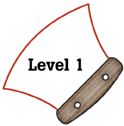
Alaska Science
Key Element A7
A student who meets the content standard should understand how the Earth changes because of plate tectonics, earthquakes, volcanoes, erosion and deposition, and living things (Processes that Shape the Earth).
 |
Alaska Science A student who meets the content standard should understand how the Earth changes because of plate tectonics, earthquakes, volcanoes, erosion and deposition, and living things (Processes that Shape the Earth). |
|
Performance Standard Level 1, Ages 5–7
|
|
|
|
Sample Assessment Ideas
|
|
|
Expanded Sample Assessment Idea
|
|
Procedure Students will:
Reflection and Revision
|
Levels of Performance |
||
|
Stage 4 |
Student work is complete, and shows evidence of logical reasoning. Student work shows detailed evidence of ability to sort and describe earth materials using multiple characteristics. The student sorts and describes rocks using three different characteristics. Each sort cycle includes a description of the rock groupings made using that particular characteristic. Student work describes in detail the sorting and information analysis processes used to sort and group earth materials. | ||
|
Stage 3
|
Student work, while generally correct, may contain minor errors and omissions. Student work shows evidence of ability to sort and describe earth materials using several characteristics. The student sorts and describes rocks using at least two different characteristics. Most sort cycles include a description of the rock groupings made using that particular characteristic. Student work describes the sorting process and analyzes the information collected during the sorting process | ||
|
Stage 2
|
Student work contains errors and omissions. Student work shows limited evidence of ability to sort and describe Earth materials. Student may not describe the sorting process or analyze information about the rocks. | ||
|
Stage 1
|
Student work is largely incomplete or incorrect and shows little or no evidence of ability to sort or describe earth materials. | ||
Standards Cross-References
|
||
|
National Science Education Standards Earth materials are solid rocks and soils, water, and the gases of the atmosphere. The varied materials have different physical and chemical properties, which make them useful in different ways, for example, as building materials, as sources of fuel, or for growing the plants we use as food. Earth materials provide all of the resources that humans use. (Page 134) Soils have properties of color and texture, capacity to retain water, and ability to support the growth of many kinds of plants, including those in our food supply. (Page 134) The surface of the earth changes. Some changes are due to slow processes, such as erosion and weathering, and some changes are due to rapid processes, such as landslides, volcanic eruptions, and earthquakes. (Page 134) |
Benchmarks Chunks of rocks come in many sizes and shapes, from boulders to grains of sand and even smaller. (Page 72) Change is something that happens to many things. (Page 72) Animals and plants sometimes cause changes in their surroundings. (Page 72) |
|
Table of Contents | Return to Alaska Native Knowledge Network